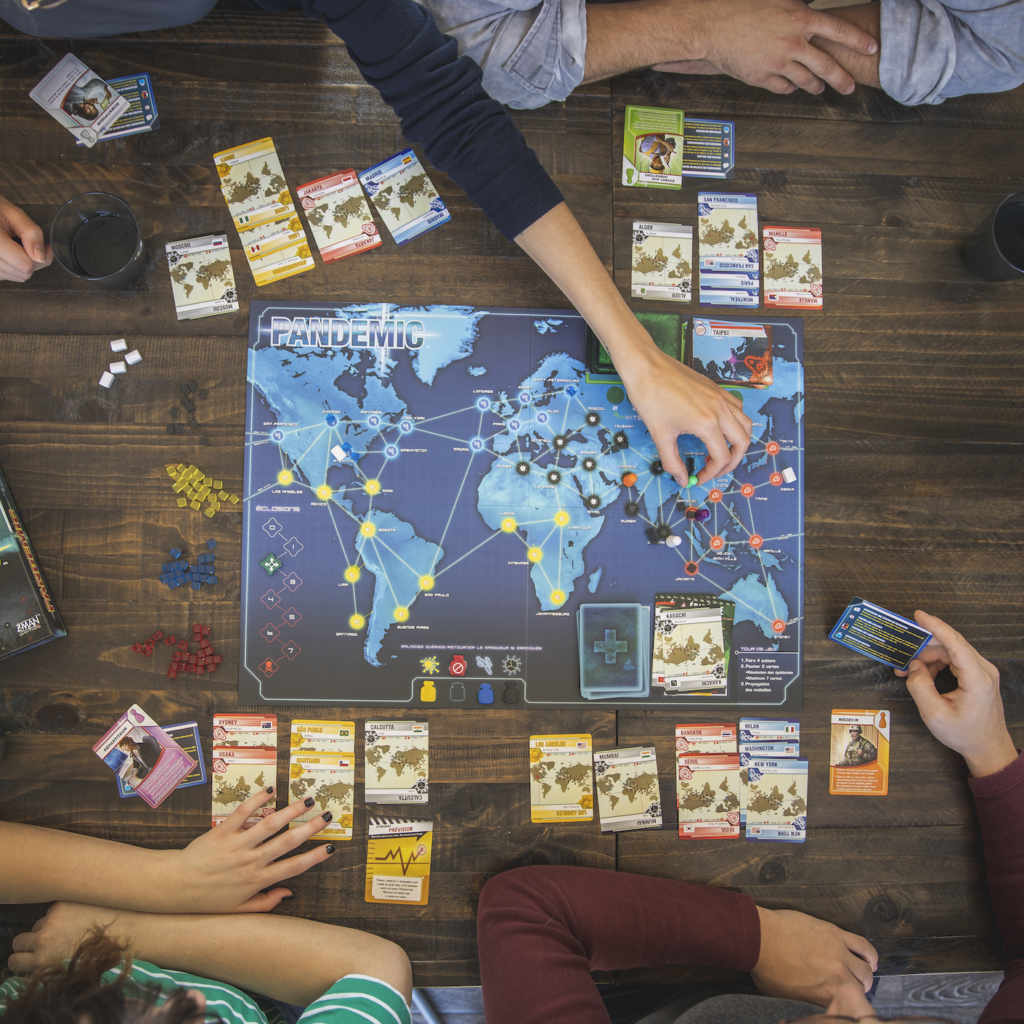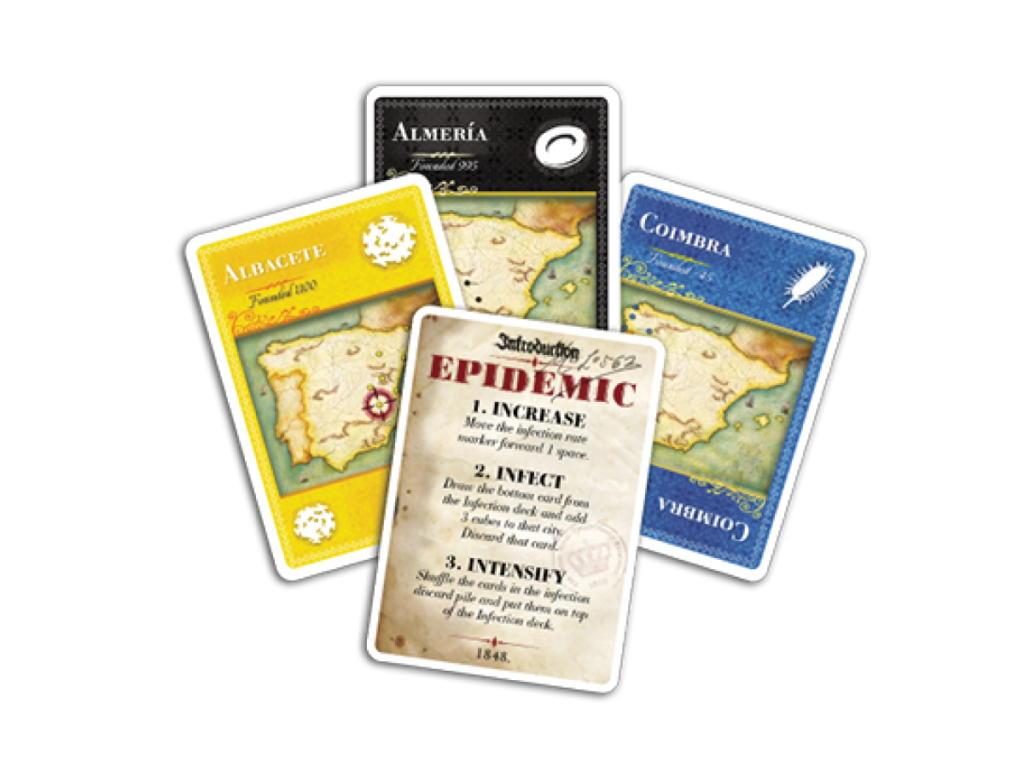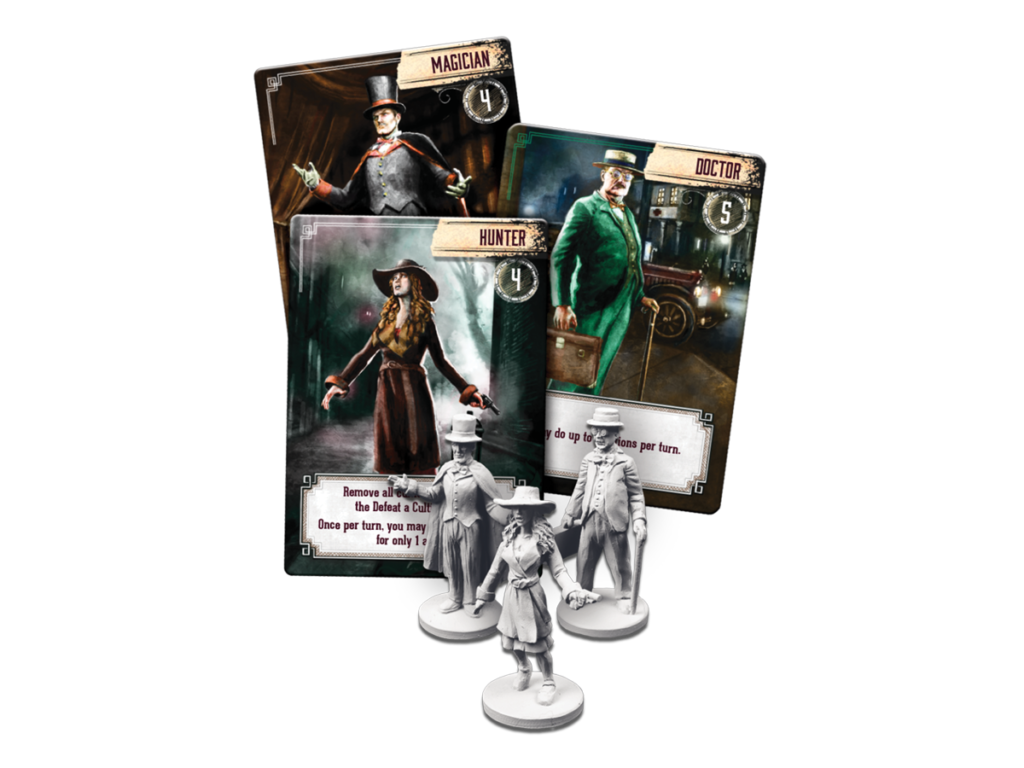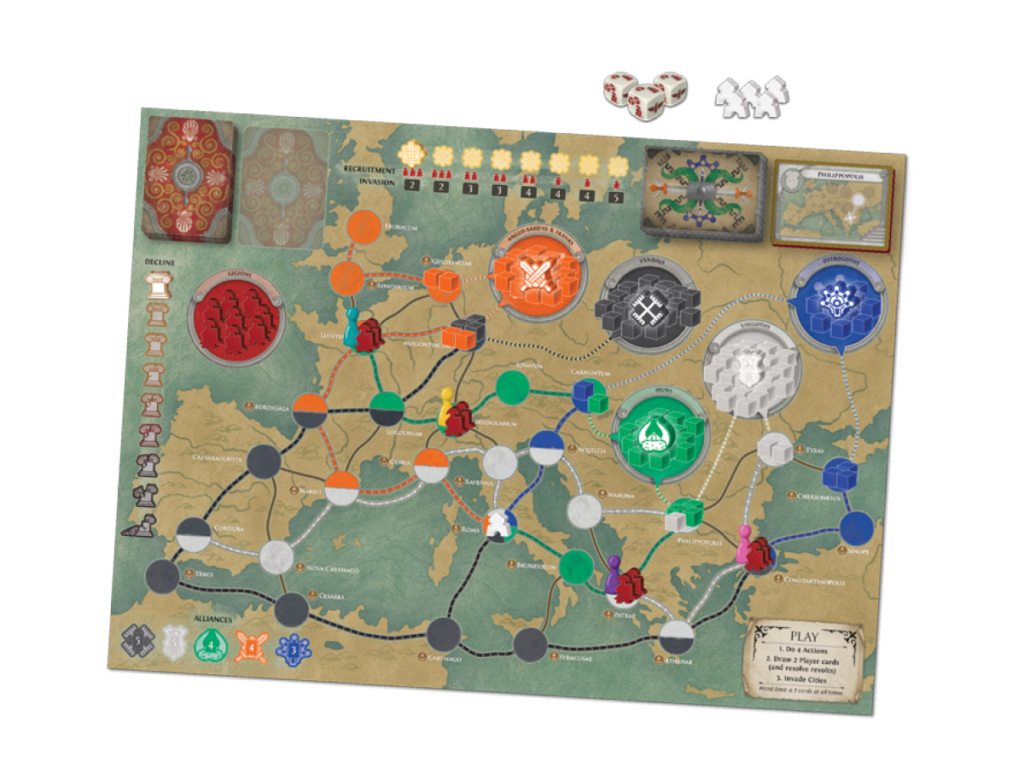The system that evolved from the beloved cooperative game
In 2008, Pandemic was released, introducing players to Matt Leacock’s intricate, cooperative gameplay system. Since then, many other games, both standalone and expansions, have spawned from the base Pandemic. Many of these titles are built within the Pandemic universe, focusing on science and medical threats and solutions to push the game along. However, a few were designed outside of that for the Pandemic Survival competition, an organized play format. The games that came out of this tournament style format went to not only different time periods, but also explored different threats and stories, creating the beginnings of the Pandemic System.
Games that are part of the Pandemic System build upon the concepts the base Pandemic game is designed around, while integrating their own unique features and mechanics that are relevant to their unique setting and story.

Core Mechanics of Pandemic
These are the mechanics you will find in all Pandemic games. They may vary, and some may even be called something different, but their base concepts and what they add to the gameplay stay the same.
Characters
Complimenting the teamwork based gameplay Pandemic is so known for, each game gives players several unique characters to choose from. The chosen character represents the player in the game world, and can contribute to the game in different ways depending on their unique character ability.
Speaking of…
Abilities
Across the various games, each character has at least one (sometimes more) special abilities that players can utilize. These abilities come in a variety of uses, and help players strategize together on how best to accomplish their goals and how each ability may help with that.
Abilities can range from giving the player or companions extra movement, extra actions on a turn, advantage in certain situations, and much more.
Cards
In order to give players the assistance they need, a player deck is a core feature in Pandemic games. Cards are drawn from the player deck each turn, often representing locations, which players can utilize to quickly move to or from said location, trade with other players, or collect many to complete one of the goals essential to victory. However, there are also a few cards in the deck that can cause problems for the players, often resulting in more threats being placed on the map.


Dealing with a Spreading Threat
Those who have played Pandemic will probably remember treating diseases to prevent them from spreading, and finding a cure for them so they can be stopped once and for all. This mechanic is present in all Pandemic System games. However, outside of Pandemic: Iberia, its representation is not diseases or finding cures, but dealing with a threat that continues to spread across the board, such as flooding waters, hordes of enemies, or even supernatural threats. Throughout each game, players attempt to remove whatever components are used to represent the threat that game has created.
Threat Deck
The threat deck is how Pandemic games keep a constant and growing threat to the players on the board, and this is true in the Pandemic System titles. Every turn, cards are drawn from this deck with location names on them, and components are placed on these locations to signify the spreading threat. As the game moves closer to the end, the threat grows as more components are placed on the board each turn.
Threat Build Up
When too many threats have built up in a single area, it spreads to nearby locations. Other events, usually when drawing a specific card unique to each game, will also result in the threat spreading, but will also see the threat deck reset itself by having players shuffle the discarded cards before placing them back on top. Locations that had already been drawn can now be drawn again, and oftentimes this results in more cards having to be drawn from the threat deck during that phase in the game. This also moves the players closer to defeat, as too many instances like these will result in a game over.
Pandemic System Games

Iberia
In 2016, Z-Man Games released the first of the Pandemic System games. Set in 19th century Spain, Pandemic: Iberia takes the classic Pandemic formula and dresses it in 1800s garb. Instead of the standard elite disease control unit, players are a part of the Second Royal Philanthropic Expedition as they attempt to discover the origin of four devastating diseases. Like all Pandemic games, each character brings their own unique abilities and strategy to the team. However, these characters are more thematic to the setting, including the likes of Royal Academy Scientist, Rural Doctor, Railwayman, and more.
Much like in the Pandemic games before Iberia, you can treat diseases to get rid of disease cubes in cities you pass through, as well as collect cards in order to “research a disease.” Researching all four diseases is the equivalent to finding the four cures in the original game. However, researching is all you can do. In the 1800s, discovering how to combat diseases was difficult enough, so curing is out of the question.
One of the new ways you can keep diseases at bay, however, is the “Purify Water” mechanic. When diseases ran rampant in the 19th century, clean water was essential for survival. As an action, a player can add two purification tokens to a region. When a disease cube would be put on one of the cities in that region, a token is removed instead. Once a disease is researched, purifying water becomes even easier, giving players a new advantage against that particular disease.
Railroads are another new addition, and present players the ability to streamline their travel across Spain. The 19th century saw the beginning of railway travel across the Iberian peninsula. To represent this historical advancement within the game, the map of Iberia contains both solid and dotted line paths to cities. As an action, players can choose to place one of their limited quantity of railroad pieces on a solid line. The more railways you place that are connected to other places, the faster you are able to get to cities farther away in a single action.
In addition to the new mechanics, Pandemic: Iberia also presents players with a couple of interesting challenge modules. In the “Influx of Patients Challenge,” the game simulates the scenario of overrun hospitals. Disease cubes are treated as patients that must be moved to different hospitals so as not to overrun them, and purification tokens are far more limited.
In the “Historical Diseases Challenge,” each disease is named after one of the notably terrible diseases from the era, and is given more challenging characteristics such as being harder to treat, and having more dangerous outbreaks and faster infections. The diseases are Malaria, Typhus, Cholera, and Yellow Fever.



Rising Tide
Set in the Netherlands at the dawn of the Industrial Age, Pandemic: Rising Tide steps away from the medicine and viruses and replaces them with the threat of the North Sea reclaiming the land. Players team up as Dutch civil officials, each with unique abilities, attempting to keep the water at bay as they build dikes, pumps, and attempt to find the means to construct hydraulic structures to protect them from the rising tide. These characters include Pump Operator, Hydraulic Engineer, Port Master, and several others whose title and abilities fit the theme of this adventure.
In Rising Tide, treating diseases comes in the form of pumping water out of regions to keep flooding to a minimum, shown in the form of water cubes. This water will continue to flow to connected regions if not stopped by building dikes or pump stations. Each turn, dikes fail and the flow of water continues into connected areas with no dikes, so keeping the water under control is a challenge. In response, finding a cure equals developing 4 hydraulic structures, each granting special benefits to the players once constructed. When all 4 are finished, the game is won.
Player actions remain much the same, though in Rising Tide they have the option of building a port, which allows them to return to that region as an action. Players may (and should) pump water and build dikes to keep the flooding under control. Further complicating things, epidemics are known as storms, and much like on the sea, they can take you by surprise and completely decimate your hard work. When a storm card is drawn, a greater number of dikes are destroyed and the water levels rise in certain regions. This game is a constant struggle against the encroaching sea, and if players are unable to place the needed number of water cubes on the board, they lose.
Fall of Rome
Moving further away from the standard Pandemic game, Pandemic: Fall of Rome takes players to the beginning of the 5th century as an unstable political system and encroaching barbarians threaten the faltering Roman Empire. In this title, players work together as soldiers, citizens, politicians, and more to fight against the decline of Rome and battle the invading barbarian tribes. Included characters are Magister Miltum, Vestalis, Mercator, and many more that add their own thematic personality and abilities to the game.
You’ll find no diseases or rising tides here. The colored cubes represent the five invading barbarian tribes as they follow their specific migration path (marked by their corresponding color) through the unfortunate cities. Players must work together to defeat the barbarians and keep the invasions under control. If cities are not defended, the barbarians sack them as they move closer to Rome. If Rome is ever sacked, the game ends.
In order to keep the barbarians at bay, players must enter battle, a unique mechanic introduced in this title. Players can recruit legionnaires from forts they can construct in a city. As an action, players can use these legionnaires to battle barbarians in the same city as them by rolling dice. The faces on the dice call for players to remove their own legionnaires, remove barbarian cubes, and activate their own special abilities, which vary from character to character. Players may also leave legionnaires in cities. When a barbarian cube would be placed in a city with a legionnaire, that legionnaire defends the city and is removed instead.


It isn’t all about fighting, however. In fact, in order to win the game, players must strike an alliance with each of the five barbarian tribes. When an alliance is forged, players can recruit the barbarians to their own army. When an alliance is struck with all five tribes, players win the game.
However, battle and conflict are ever present. With the struggling empire faltering, revolts are inescapable. In place of epidemics, revolt cards cause the invasion rate to increase, increasing barbarian presence in certain areas, and lessening the number of legionnaires you can recruit during the Recruit Army action for the rest of the game.
Like outbreaks in the base Pandemic game, the decline of the empire is charted through the decline marker, and can be worsened by things like cities being sacked. When it reaches the bottom, it’s game over. Tied to the decline of the empire, event cards now come with a special twist that can both help and hinder progress. Each card has two effects, with the second one granting much more to the players, but at the cost of increasing the decline, pushing the game closer to a loss. Desperate times call for desperate measures, and players must decide as a team what is worth it.

Reign of Cthulhu
From historic time periods to the realms of madness, Reign of Cthulhu takes the familiar formula and gives it a twist of cosmic horror. Players take on the roles of investigators, each one featuring a unique skill to help them and their teammates fight against the minions of the Old Ones as they try desperately to hold onto their sanity and attempt to seal the interdimensional gates that have opened around the city. The characters in this title are more reminiscent of those found in the Lovecraftian tales, such as Detective, Hunter, Occultist, Reporter, and several others.
In Reign of Cthulhu, one of the new core mechanics is sanity. Playing into the theme of cosmic horror, each player has an amount of sanity when they start. When certain things happen, the sanity die is rolled, and the player either retains their sanity, or loses some. When that resource is depleted, the character goes insane. Their card is flipped over, and their original ability is replaced with a new one that can still be helpful, but also is detrimental in some way.
Similar to Fall of Rome, enemies stand in your way as you traverse the map. However, cubes are replaced with miniatures of cultists, who can be defeated with an action from the player. Be careful, though, as cultists aren’t the only enemy on the board. Shoggoths, servants of the Old Ones, are large monstrosities that take three full actions to defeat, and your sanity is at risk just being near one of these abominations.
There are no cures to find in Reign of Cthulhu because there is no cure for the madness the Old Ones bring. Instead, all the players can do is try to seal the four gates and keep the Old Ones from awakening…for now. When all four are sealed, the players win. If the gates are left open, the Shoggoths make their way in, waking an Old One, which has disastrous and often permanent consequences for players. If all the Old Ones in game are awakened, Cthulhu rises and the players lose. Players are welcome to use the gates while they remain open for quick travel, as they are connected to one another. However, like everything to do with the cosmic horrors you fight, your sanity is at risk.
Relics are introduced in this title, and can be drawn from the player deck. These unique cards are ancient items infused with forbidden knowledge, and can offer some much needed help to the players. However, to use a relic is to glimpse beyond the veil, and the price for such an act is one’s sanity, forcing players to roll the sanity die.
Sadly, the Old Ones do not simply have to wait for the Shoggoths to awaken them in the gates. Whenever a card titled Evil Stirs is drawn, bad things happen. An Old One awakens, and players must try to keep the little sanity they have as they roll the die.

The Pandemic library is vast with many titles to choose from. For those looking for something outside the classic Pandemic setting and formula, the Pandemic System games are unique, thematic, and the number of titles is growing. Expand your collection with these titles and add an exciting mix of variety and personality to your game night.
If you are interested in more Pandemic System games, be sure to keep an eye on our social media for more in the future.


